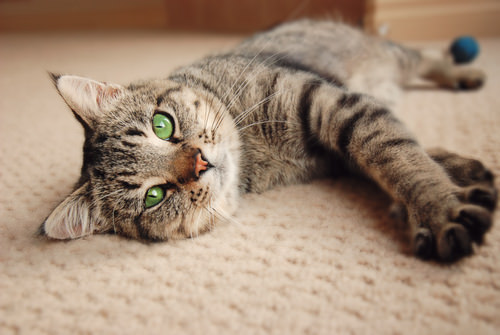
Cat purrs are wonderful. We, humans, respond well to the frequency of a purr and it seems to make us happy. Some people say that the frequency of the actual sound can produce healing. But no one can say for sure why cats purr. It is interesting to note that felines that can roar cannot purr and those that purr cannot roar.
There are some anatomical differences between roaring and non-roaring cats. It was discovered that the lion and the other roaring cats possess an incompletely ossified hyoid apparatus (a delicate boney box in the throat). Whereas the domestic cat has complete ossification, possibly facilitating the purr.
- Contentment: Obviously most cats purr when they are happy and content. A study on the vocalizations of animals found that cats perceive the sound of purrs (and meows) with the left hemisphere of their brain, while they seemed to perceive danger and emotion vocalizations with the right.
- Asking for reward: Cats also seem to have learned to associate purring with their humans feeding them as well and will approach their meal with loud purrs. These trained human minions perform the feeding task obediently at the sound of the purr thereby rewarding the purr behavior and assuring its perpetuation.
- Distress: But some cats seem to purr when they are distressed. Perhaps there is a subtle difference in the frequency of the purr for distressed cats versus happy cats, but humans are unable to tell the difference. Only the situation and body language of the cat can give us clues to the meaning of an individual purr.
Cat lovers can usually tell if their cats is distressed or content and more often than not, a purr is a really good thing, so it is probably safe to keep doing what you are doing that makes your cat purr.
Love cats? So do I! Find me on Facebook and join the conFURsation!
- Frequency Characteristics in Animal Species Typically Used in Laryngeal Research: An Exploratory Investigation.J Voice. 2015 Dec 8. pii: S0892-1997(15)00237-4. doi: 10.1016/j.jvoice.2015.10.019. [Epub ahead of print]Riley JL, Riley WD, Carroll LM.
- Auditory lateralization of conspecific and heterospecific vocalizations in cats. Laterality. 2016 May;21(3):215-27. doi: 10.1080/1357650X.2015.1116541. Epub 2015 Nov 30Siniscalchi M, Laddago S, Quaranta A
